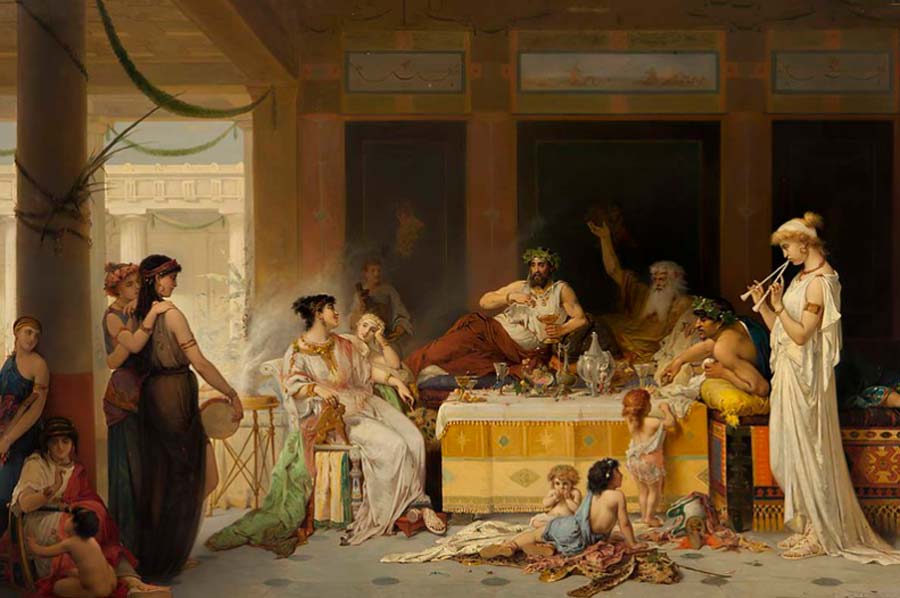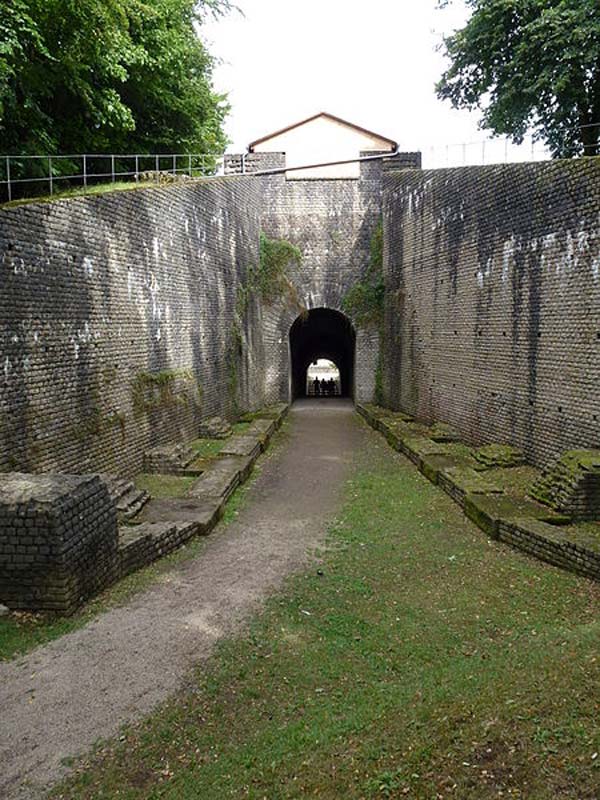Ancient Rome has been presented as a place full of excesses of luxury and consumption. So much so that wealthy Romans were supposed to have a separate room dedicated to emptying their stomach during banquets, by vomiting.
However, more recent research has shown that this may not have been the case. The word “vomitorium” itself presents an image in our minds that is different than what was the reality. To understand why there is this misconception, a history of the word should be explored.
What’s In A Name?
Aldous Huxley, in his 1929 comic novel Antic Hay where he depicts the cultural elite in post-World War one London, wrote of one of his characters that “the door of his sacred boudoir was thrown rudely open, and there strode in, like a Goth into the elegant marble vomitorium of Petronius Arbiter”. This is one of the first times that the word vomitorium was used, or rather misused in this way, in reference to a room for vomiting.

However, there are even earlier misconceptions of the vomitorium. In 1871, French journalist Felix Pyat described Christmas in England as a “gross, pagan, monstrous orgie – a Roman feast, in which the vomitorium is not wanting.” So even in the late 19th century, there was an idea of a room used in Rome specifically for vomiting food away.
Throughout this period of the 19th and early 20th century, pieces were written such as Augustus Hare’s “Walks in Rome” in which is described the chamber adjacent to the dining room of the Flavian Palace, to be used as a vomitorium. It was here that Hare imagined Nero had poisoned Britannicus and that Marcia drugged Commodus. These pieces were criticized by contemporary archaeologists as fanciful, warning that Roman archaeology is too technical to be dealt with by an amateur.
But where did this idea come from?
Imperial Excess
The idea of gluttonous Romans and even more gluttonous Roman emperors stems from the courtier Petronius, and his satire piece “Satyricon” written in the 1st century AD. However, Petronius never actually mentioned a room specifically for vomiting. He instead refers to one character’s bowel movements at dinner.
- History of Pompeii: Its Rise, Decadent Heyday, and Destruction
- Roman Concrete: Volcanic Material Created An Empire
This does not lead us to the specific room though. For stories dedicated to dinner time vomiting and to man’s excess, Suetonius and Cassius Dio are the sources that are needed.

Suetonius wrote a history on the lives of the Caesars using court records. while Cassius Dio was a Roman Statesman and historian who published over 80 volumes on the Roman past. Suetonius records that Emperor Claudius always finished his meals by being excessively bloated with food and wine. To deal with this, Claudius would lie down and have a feather inserted into his throat to induce vomiting. This would clear his stomach and allow him to continue feasting.
Cassius Dio writes of the Emperor Vitellius, who used to feast four times a day. He would like to sample foods from all across the empire and would taste everything that he could get his hands on. He tried exotic foods, which included brains of pheasants and flamingo tongues. Cassius claims that to keep eating, the emperor would vomit so that he could continue to consume food.
Importantly, both of these writers used these examples as ways to detract from these characters. It was a moral comment on the state of Rome. They were claiming that luxury was not the way of the true Roman, and inviting the reader to be disgusted with these characters. In reality, vomiting was more of a medical practice for Romans than a sign of luxury.
So What Was A Vomitorium?
Vomitoria certainly existed for the Romans, but in a very different sense. They were definitely known by the fourth century AD, when Macrobius, a Roman provincial and writer, used the word to refer to amphitheater passageways that “disgorged” its patrons to their seats. In this context they are simply passageways, and those in the Colosseum in Rome were apparently so efficient that with 76 different “vomitoria”, the venue of 50,000 could be filled in 15 minutes.
- Hellfire Club History: Beginnings of the Infamous Secret Society
- Two Roman Emperors With a Social Conscience
The term is still used today as an architectural term used to describe the passageway or corridor of an amphitheater connecting the bank of seats to the outside space. The idea is that spectators could “spew forth” into their seats at public entertainment. They are designed to effectively allow entrance and exit from stadiums. This is perhaps a slightly less exciting history of the word but a little more sanitary.
Bad Reputation
It is easy to see why there was a misconception between the words and the meaning behind them. However, why was it so easy to believe this about the Romans? Literature and films are littered with depictions of the wretched excesses of Roman emperors and their subjects, who are commonly depicted as wealthy and living lives of leisure.

Contemporary Roman social commentators such as Pliny the Elder and Seneca described their behavior in such a way. Overindulgences of some Roman nobles provided accounts and incidents provided much source material for a derogatory picture of Rome. They used their writings to criticize their peers and hopefully encourage better behavior in Rome.
It was writings like this that inspired urban historian Lewis Mumford to misunderstand the vomitorium in his work “The City in History”. He recorded that “overzealous Roman eaters would throw up the contents of their stomachs”. They would do this, he claimed, so that they could return to their couches and continue the party. It should be noted that Mumford did correct himself and later link the vomitorium to exits from a theatre.
The True Vomitorium
The vomitorium may not have the dark and disgusting history that has been presented but it still makes for an interesting story. Some modern theatres still incorporate ‘Voms’ in their architecture and terminology. A director can still tell an actor to leave via “stage right vom”. Also, when designing theatres, voms are still used for the movement of the audience to enter and exit. It may be true that some ancient Romans used to overindulgence, but it seems very unlikely that this stretched as far as a separate room for vomiting after eating.
Top Image: The traditional view of a Roman feast. Source: Galdalf’s Gallery / CC BY-NC-SA 2.0.
By Kurt Readman